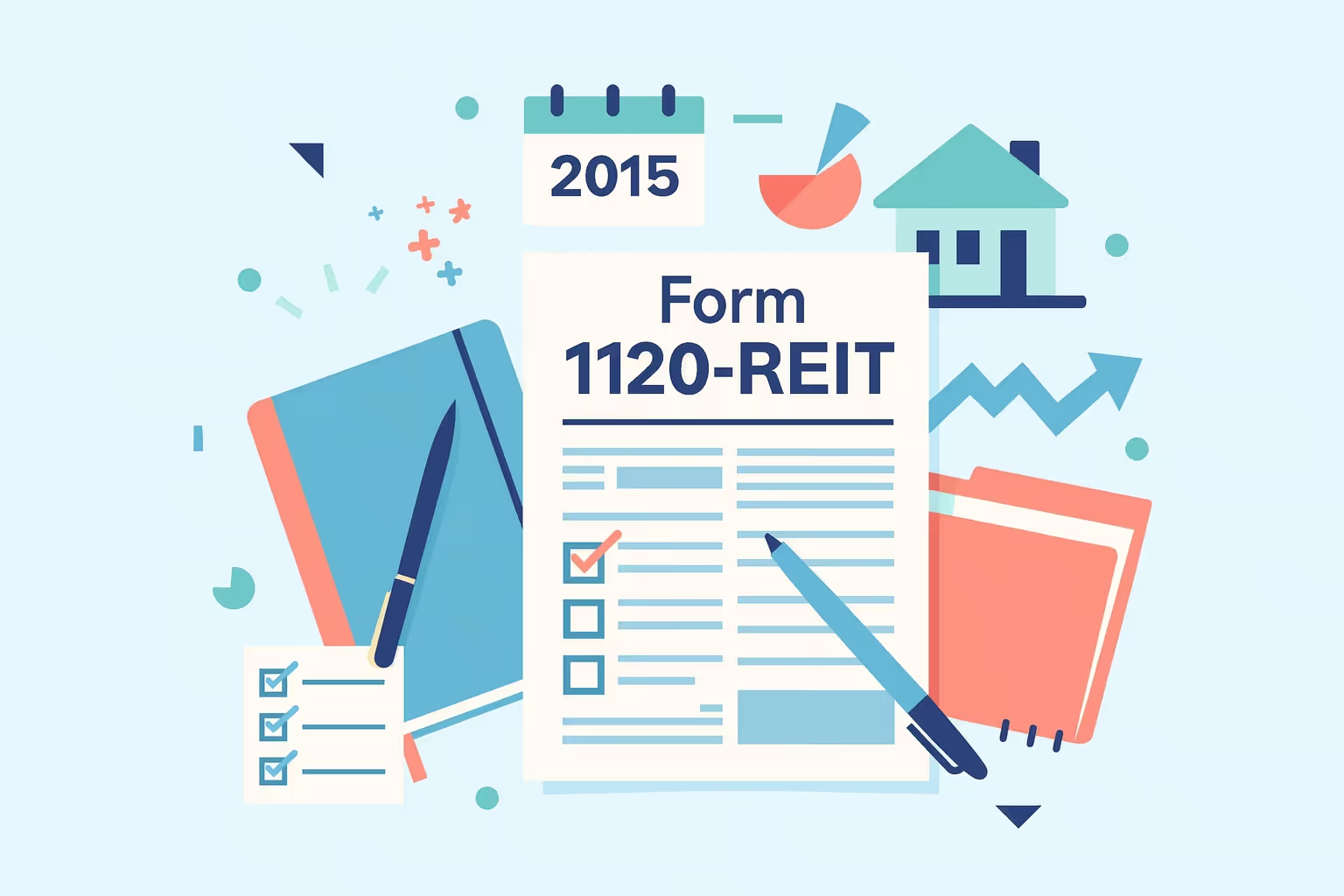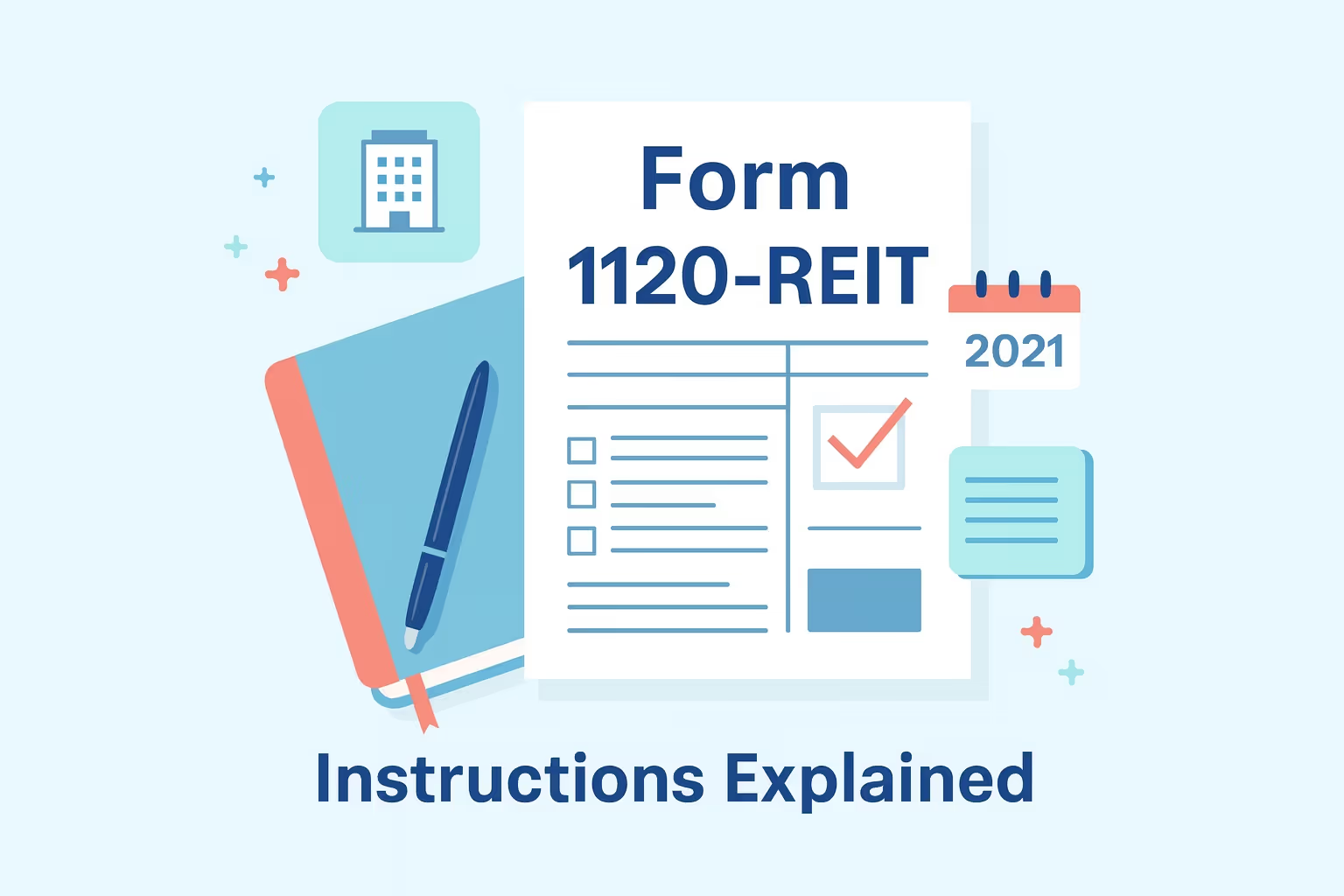Essential Guide to Form 1120-REIT 2023 Instructions
Real Estate Investment Trusts (REITs) use Form 1120-REIT to file federal income tax returns with the IRS. This form shows their yearly income, deductions, and tax obligations. It is the most important document that ensures each REIT follows federal tax law and maintains its unique status under the Internal Revenue Code. If a trust or corporation fills out Form 1120-REIT correctly, it can keep track of its business income, dividends, and expenses while also meeting the IRS's requirements for qualification and distribution.
This form is for companies that have chosen to be treated as REITs. These are usually corporations, trusts, or associations that primarily invest in real estate and give their shareholders most of their taxable income. The Form 1120-REIT 2023 instructions provide detailed steps for completing and submitting the return, including updated reporting rules, penalty thresholds, and e-file mandates. Whether the entity has extensive real estate holdings or experienced a year of limited activity, it must still submit a federal tax return to preserve its REIT election and remain in good standing.
This guide simplifies the official IRS 2023 instructions for REIT filers. It walks through each preparation stage—from gathering financial information to attaching schedules and submitting payments. By following these steps, people who file taxes can lower their chances of getting in trouble, make sure their calculations are correct, and show that they follow IRS rules. It's essential to file correctly to avoid mistakes, keep REIT eligibility, and protect shareholder value.
What Is Form 1120-REIT
Real Estate Investment Trusts (REITs) use Form 1120-REIT to file their federal income tax returns, which show their income, deductions, dividends, and tax liabilities. It is different from the standard corporate return because it only applies to companies that have chosen to be REITs under the Internal Revenue Code (IRC). These companies can avoid paying taxes twice if they follow ownership, income, and distribution. rules
A REIT is typically a corporation, trust, or association that earns income from real property such as commercial buildings, apartments, or mortgages. The entity must meet ongoing income, asset, and shareholder tests to maintain this status. When qualified, REITs can deduct dividends paid to shareholders from their taxable income, reducing overall federal income tax.
Form 1120-REIT contains sections specific to REIT operations, including the dividends-paid deduction, qualification tests, and capital-gain reporting. Filers must complete these accurately to remain compliant with IRS requirements. For official instructions, visit the IRS Form 1120-REIT page.
Who Must File Form 1120-REIT
Entities must file Form 1120-REIT if any of the following apply:
- Corporations, trusts, or associations have elected to be treated as Real Estate Investment Trusts (REITs) under IRC §§ 856–857.
- They continue to hold REIT status from a prior tax year and must report current-year income or compliance details.
- They intend to maintain their REIT election during a tax year with minimal business activity.
Even REITs reporting no business income must file annually to maintain their election and remain compliant. Failure to file may result in automatic termination of REIT status and loss of related tax benefits.
Key Filing Benefits
Filing Form 1120-REIT correctly provides several significant advantages:
- Maintaining REIT status: Filing annually verifies compliance with the REIT qualification rules under the Internal Revenue Code.
- Claiming the dividends-paid deduction deduction deduces taxable income by allowing REITs to exclude most shareholder distributions from their federal income tax return.
- Demonstrating transparency: Reporting accurate income and distributions helps shareholders correctly calculate their personal tax obligations.
- Avoiding penalties: Timely and complete filing helps prevent costly IRS penalties or the loss of REIT eligibility.
By understanding these fundamentals, filers can prepare more confidently before completing the detailed 2023 Form 1120-REIT instructions in the next section.
What’s New for the 2023 Tax Year
The 2023 Form 1120-REIT instructions include several important updates that affect how Real Estate Investment Trusts (REITs) file their federal income tax return. Each change impacts reporting, deductions, or filing procedures, so filers must review these revisions carefully.
Key updates for 2023 include:
- Higher penalty for late filing: The minimum penalty for failing to file a return more than 60 days after the due date has increased to $485 or the amount of tax due, whichever is smaller. This update reinforces the importance of submitting the income tax return on time.
- Reduced business meal deduction: The temporary 100 percent deduction for business meal expenses expired at the end of 2022. For 2023, REITs may deduct only 50 percent of qualifying meal expenses, returning to the pre-pandemic limit.
- Energy-efficient building deduction change: REITs claiming the Section 179D deduction for energy-efficient commercial buildings must now report it on line 18 of Form 1120-REIT. This adjustment modifies the reporting location from prior years.
- Elective payment provisions: Certain credits can now be treated as elective payments, allowing eligible REITs to receive refundable amounts even when no tax liability exists.
- Expanded e-file mandate: Any REIT filing 10 or more returns in a calendar year must now file electronically under updated IRS requirements.
For complete details, review the official 2023 Instructions for Form 1120-REIT. Understanding these changes helps REITs avoid penalties, file accurately, and use available deductions and credits.
Step-by-Step Instructions for Completing Form 1120-REIT
This section explains how to prepare, complete, and review Form 1120-REIT, the federal income tax return for Real Estate Investment Trusts (REITs). Each step emphasizes accuracy, compliance, and attention to detail so that REIT filers can meet IRS requirements for the 2023 taxable year.
Step 1 – Gather Your Information
Before beginning the form, REITs should collect all records and documentation needed for accurate reporting. Having complete and organized data helps prevent filing errors and ensures consistency across schedules and statements.
Essential documents include:
- The REIT’s Employer Identification Number (EIN), legal formation documents, and fiscal or calendar year details.
- Complete financial statements showing gross income, business income, and deductions for the reporting period.
- Records of shareholder distributions to support the dividends-paid deduction calculation.
- Asset listings that include property values, acquisition dates, and depreciation details.
- Copies of prior-year returns to confirm carryforwards, elections, and adjustments.
These documents form the foundation for preparing an accurate and compliant federal tax return.
Step 2 – Complete Header and General Information
The header establishes the REIT’s identity and filing period. Enter the correct taxable year or fiscal year ending date. Provide the legal name, current mailing address, and EIN exactly as they appear in IRS records. Report total assets at the end of the year and the date the REIT election became effective.
Also, indicate the accounting method used, such as cash or accrual, and disclose any approved changes. This must be clearly stated if the REIT belongs to a controlled group or affiliated structure. Correctly completing this section ensures that the IRS can match the return to the proper entity and filing period.
Step 3 – Part I: Taxable Income Computation
Part I calculates the REIT’s taxable income before applying any special deductions. Begin by reporting all gross income from real property rents, interest, dividends, and real estate or securities sales. Next, list allowable deductions such as wages, repairs, taxes, interest, and depreciation.
Adjust for non-deductible or limited items as required under the Internal Revenue Code. After completing these entries, subtract total deductions from gross income to determine taxable income before the dividends-paid deduction. Maintaining precise records for each entry helps verify figures in the event of an IRS inquiry.
Step 4 – Parts II–IV: Capital Gains, Tax, and Payments
In Part II, report all capital gains and losses, attaching Schedule D and Form 8949 when applicable. In Part III, calculate the REIT’s tax, including any tax on undistributed income, built-in gains, or excise taxes related to qualification failures.
Part IV summarizes total tax, payments, credits, and any balance due or refund expected. Include estimated tax payments and prior-year overpayments applied to the current year. Verify whether the REIT meets the electronic filing requirement for entities that file ten or more annual returns. These steps ensure accurate reporting of REIT capital gains and compliance with IRS electronic filing rules.
Step 5 – Attach Required Schedules
Each required schedule supports the figures reported on the main form. Completing these schedules helps the IRS confirm accuracy and maintain the REIT’s eligibility for special tax treatment.
Key schedules include:
- Schedule A: Calculates the dividends-paid deduction based on distributions made to shareholders.
- Schedule K: Reports ownership details, activities, and compliance information for the tax year.
- Schedules L, M-1, and M-3: Reconcile book income with taxable income and provide beginning and ending balance sheets.
- Additional Forms: Attach Form 8949 for asset sales, Form 5471 for foreign corporation interests, and Form 8865 for foreign partnership activities, if required.
Arrange all schedules in the order listed in the official instructions to support faster processing by the IRS.
Final Review Before Filing
Before submitting Form 1120-REIT, review all information carefully. Ensure that the totals across all schedules and forms align with the supporting records. Ensure an authorized officer signs the form and all entries are legible and complete.
Keep all records, schedules, and financial documents for at least three years after the due date. A thorough review before filing helps maintain compliance, qualify for deductions, and reduce the risk of penalties when submitting the federal income tax return.
Filing and Payment Methods
The IRS provides several methods for submitting Form 1120-REIT and paying federal income tax. Choosing the correct filing and payment process helps Real Estate Investment Trusts (REITs) meet compliance obligations and avoid penalties.
Electronic Filing Requirements
For tax year 2023, most REITs are required to file electronically. Under the IRS mandate, any corporation or trust that files 10 or more returns in a calendar year must e-file. This rule includes income, employment, and information returns.
To file electronically:
- Use an IRS-authorized e-file provider or approved tax software.
- Complete all parts of Form 1120-REIT and attach the required schedules electronically.
- Review the return for accuracy and electronically sign it using Form 8879-C, IRS e-file Signature Authorization for Corporations.
- Transmit the return through the e-file system and retain the confirmation receipt as proof of submission.
Electronic filing is faster, reduces errors, and ensures the IRS receives the return before the due date.
Paper Filing Option
If a REIT is not required to file electronically, it may submit a paper return. The mailing address depends on whether the entity is enclosing a payment.
- Without payment:
Department of the Treasury
Internal Revenue Service Center
Ogden, UT 84201-0027 - With payment:
Internal Revenue Service
P.O. Box 409101
Ogden, UT 84409
When filing by mail, use black ink, sign the form manually, and attach all supporting schedules correctly. Paper filers should allow additional processing time for the IRS to record receipt.
Requesting a Filing Extension
Suppose more time is needed to complete the return. In that case, REITs can ask for an automatic six-month extension by filling out Form 7004, "Application for Automatic Extension of Time To File Certain Business Income Tax, Information, and Other Returns."
It is important to remember that an extension gives you more time to file, not to pay. You must still pay any taxes due by the original date to avoid paying late fees and interest.
Making Tax Payments Electronically
All REITs must make federal tax payments electronically through the Electronic Federal Tax Payment System (EFTPS). After enrolling at www.eftps.gov, filers can schedule payments online or by phone. Payments must be initiated no later than 8 p.m. The submission must be made by Eastern Time on the due date to be considered timely.
REITs that expect to owe $500 or more must also make quarterly estimated payments, generally due on:
- April 15
- June 15
- September 15
- January 15 of the following year
Using EFTPS ensures immediate confirmation, accurate tracking, and compliance with federal deposit requirements for all REIT tax payments.
Common Errors and Compliance Tips
Filing Form 1120-REIT requires precision, as even small mistakes can result in penalties or loss of REIT status. Many errors stem from misreporting income, omitting schedules, or overlooking qualification requirements. The following guidance helps filers strengthen accuracy and compliance with current REIT taxation rules.
Frequent Filing Mistakes
- Missing filing deadlines: Late returns often trigger penalties and interest. REITs must file by the 15th day of the fourth month after the close of the tax year unless they have a June 30 year-end, in which case they are due on the 15th day of the third month.
- Incorrect shareholder data: The 100-shareholder test and 50-percent ownership rule must be monitored to confirm ongoing qualification. Missing or outdated shareholder records are common audit triggers.
- Incomplete schedules: Failure to attach required forms, such as Schedule A or Schedule K, can lead to processing delays and possible penalties.
- Misreported dividends or deductions: Errors in the dividends-paid deduction or taxable income calculation can distort the REIT’s tax liability and risk disqualification.
Compliance and Best Practices
- Maintain complete records: Document gross income, distributions, assets, and prior-year adjustments.
- Verify data consistency: Ensure all totals on attached schedules match the primary form.
- Use professional support: Engaging qualified tax professionals can help detect inconsistencies before filing and ensure compliance with complex reporting rules.
- Review ownership and asset tests regularly. Confirm that the REIT meets the 75-percent asset, 75-percent, and 95-percent income tests and other qualification requirements throughout the year.
- Plan for payments: Use the Electronic Federal Tax Payment System (EFTPS) to stay current with estimated tax payment obligations.
While these rules differ from those governing retirement accounts, tax-deferred account rules, or required minimum distributions for retirement plan owners—including traditional IRAs, simple IRA accounts, and other retirement plan structures—the principle is similar: each account owner must follow timelines, apply the correct life expectancy factor, and meet the first required minimum distribution deadline.
REIT filers should adopt the same disciplined approach to documentation and compliance to preserve their status and minimize IRS exposure.
Special Situations
Certain Real Estate Investment Trusts (REITs) face nonstandard filing circumstances that require close attention to maintain compliance with IRS rules. These include years without activity or the first year a REIT elects its status. Proper documentation and timely filing help preserve eligibility and prevent penalties while paying taxes accurately.
Dormant or Zero-Activity REITs
A REIT is considered dormant when it has no unearned income, business activity, or shareholder distributions during the taxable year. Even in this case, the REIT must still file Form 1120-REIT to maintain its election under IRC §§ 856–857. Missing a filing deadline can result in automatic termination of REIT status.
To remain compliant, dormant REITs should:
- File a complete return showing zero income, expenses, and distributions.
- Keep ownership and asset documentation current.
- Confirm that the REIT meets the 100-shareholder and asset diversification tests.
- Retain accurate records in preparation for future audits or reactivation.
This approach parallels how an IRA owner or account holder manages retirement accounts. Just as individuals follow RMD rules for Roth and SEP IRAs, REITs must maintain documentation even when they delay taking action or have no activity. Both must track requirements such as the first RMD, reporting separately for one account, and using the correct life expectancy factor to remain compliant.
First-Time REIT Filers
Entities electing REIT status for the first time must meet ownership, income, and asset tests outlined in IRC §§ 856–857. Proper preparation ensures that the business sponsoring the REIT can demonstrate long-term compliance.
Before filing, first-time REITs should:
- Obtain an EIN specifically for the REIT entity.
- Prepare and sign a REIT election statement.
- Verify records of income sources and shareholder ownership.
- Establish procedures for dividend tracking and financial reporting.
- Consult experienced tax professionals to confirm eligibility.
Like individuals under the SECURE Act who must begin taking RMDs from a retirement plan, REITs must follow precise rules to maintain qualification. First-time filers protect their eligibility and minimize compliance risks by applying the standard deduction correctly and organizing documentation early.
Maintaining REIT Qualification and Avoiding Penalties
Real Estate Investment Trusts (REITs) must satisfy ongoing qualification tests outlined in IRC sections 856 and 857 to preserve their tax-favored status. These requirements ensure the entity operates primarily as a real estate investment vehicle and distributes its profits appropriately.
Key compliance areas include:
- Ownership tests: A REIT must have at least 100 shareholders and avoid being closely held.
- Income and asset tests: At least 75 percent of income must come from real estate sources, while 75 percent of total assets must consist of qualifying real estate, cash, or government securities.
- Distribution requirements: The REIT must distribute at least 90 percent of taxable income to shareholders annually.
Failing these tests may subject the REIT to excise taxes, additional penalties, or loss of status. Maintaining detailed records of income sources, property transactions, and like-kind exchanges helps ensure compliance.
Proper recordkeeping for withdrawals, contributions, and distributions is vital for REITs and individuals managing Roth IRAs. Both require careful tracking to verify that the total amount distributed or contributed matches IRS limits. For taxpayers, this consistency protects against penalties and underreporting issues.
Similarly, a REIT’s qualified distribution rules function like the rules requiring a beneficiary or spouse to report RMD separately when withdrawing the full amount from a retirement account. Both cases, managing money responsibly and reporting accurately, are key to maintaining compliance and avoiding costly penalties.
Final Checklist Before Filing
Before submitting Form 1120-REIT, every filer should complete a final review to ensure accuracy, compliance, and consistency across all reported information. A well-prepared checklist helps avoid IRS delays, penalties, or rejected filings.
Use the following checklist before filing:
- Verify entity details: Confirm the REIT’s legal name, EIN, and fiscal year are correct and consistent across all forms.
- Review income and deductions: Check that gross, taxable, and deductions reconcile with supporting schedules and financial records.
- Confirm ownership compliance: Ensure the REIT meets the 100-shareholder rule and the 50-percent ownership limitation.
- Check distribution accuracy: Verify that at least 90 percent of taxable income has been distributed to shareholders as required under the Internal Revenue Code.
- Attach all schedules: Include Schedule A, Schedule K, and other required attachments in the correct order listed in the instructions.
- Validate electronic filing requirements: Confirm the REIT is properly enrolled in the IRS e-file system and that Form 8879-C is completed for electronic signatures.
- Confirm payments: Review that estimated tax and balance-due payments have been made using the Electronic Federal Tax Payment System (EFTPS).
- Retain documentation: Keep copies of the return, schedules, and payment confirmations for at least three years after filing.
Completing this checklist ensures the Real Estate Investment Trust meets every IRS filing requirement and maintains compliance for future tax years.
Frequently Asked Questions (FAQs)
Who must file Form 1120-REIT as part of their income tax return?
Any entity structured as a Real Estate Investment Trust (REIT) must file Form 1120-REIT as part of its annual income tax return. This includes corporations, trusts, or associations that elected REIT status under the Internal Revenue Code. Filing ensures continued eligibility for REIT tax benefits and compliance with IRS reporting requirements.
What is the due date for filing Form 1120-REIT?
The due date for filing depends on the REIT’s tax year. The form for calendar-year filers is due on April 15 of the following year. Fiscal-year REITs must file by the 15th day of the fourth month after the tax year ends, or the third month for those with a June 30 fiscal year-end.
How do Real Estate Investment Trusts report income tax and distributions?
Real Estate Investment Trusts (REITs) report income tax on Form 1120-REIT by listing income, deductions, and shareholder distributions. The IRS requires REITs to distribute at least 90 percent of taxable income to shareholders annually. Proper reporting ensures compliance, supports dividend deductions, and prevents the trust from being taxed as a regular corporation.
How are REIT rules similar to those for a tax-deferred account?
Much like a tax-deferred account, REITs benefit from special tax treatment when they meet regulatory requirements. Both allow account owners or entities to defer tax on earnings until distribution. Compliance with distribution and reporting rules protects eligibility for deferred taxation and minimizes the risk of penalties or reclassification by the IRS.
How do required minimum distributions relate to REIT taxation?
While required minimum distributions apply to retirement plan holders rather than REITs, the principle is similar. Both involve mandatory distributions to avoid penalties. Like a retirement plan owner, a REIT must distribute specific amounts yearly—90 percent of taxable income for REITs—to maintain compliance with IRS requirements and preserve preferential tax treatment.
























